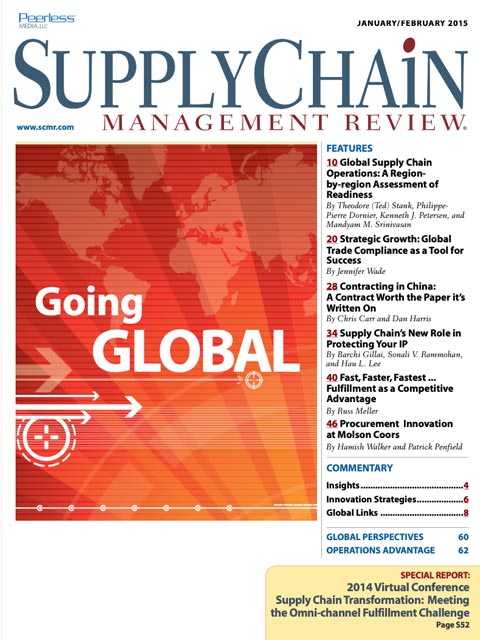Sorry, but your login has failed. Please recheck your login information and resubmit. If your subscription has expired, renew here.
January-February 2015
As long as there have been boats and beasts of burden, intrepid business professionals, governments, and marauders have sought fame, fortune, wealth, and value by going global. Think the Phoenicians, Marco Polo, and the Vikings in days of old. Or in contemporary times, think of China, BRIC, EMEA, and other emerging markets. One could argue that outsourcing to China a few decades ago gave birth to supply chain management as we think of it today. This month we’re including an online bonus column from APQC. While this issue focuses on global management, we didn’t want to miss out on the column. Browse this issue archive.Need Help? Contact customer service 847-559-7581 More options
A new study from the University of Tennessee’s Global Supply Chain Institute suggests that there may be a reversal of outsourcing trends in the coming years as U.S. companies test the local waters. Research by The Boston Consulting Group (BCG) comes to a similar conclusion, while contrarian analysts at AlixPartners sound a note of caution.
Reducing total landed cost was the goal of many U.S. companies moving manufacturing to Asia in the past decade. But that may have been a faulty proof, say researchers at UT’s Global Supply Chain Institute. Evidence from new research, suggests a more localized supply chain for many products may soon be making a comeback.
“Countless factors can harm performance when supply chains are stretched across the globe,” says Ted Stank, UT Bruce Chair of Excellence and one of the co-authors of the study. “The most successful companies evaluate the local variables before jumping into a global supply chain and design a dynamic network less vulnerable to the pitfalls of modern globalization.”
 |
This complete article is available to subscribers
only. Click on Log In Now at the top of this article for full access. Or, Start your PLUS+ subscription for instant access. |
SC
MR
Sorry, but your login has failed. Please recheck your login information and resubmit. If your subscription has expired, renew here.
January-February 2015
As long as there have been boats and beasts of burden, intrepid business professionals, governments, and marauders have sought fame, fortune, wealth, and value by going global. Think the Phoenicians, Marco Polo, and… Browse this issue archive. Access your online digital edition. Download a PDF file of the January-February 2015 issue. |
Download Article PDF |
A new study from the University of Tennessee’s Global Supply Chain Institute suggests that there may be a reversal of outsourcing trends in the coming years as U.S. companies test the local waters. Research by The Boston Consulting Group (BCG) comes to a similar conclusion, while contrarian analysts at AlixPartners sound a note of caution.
Reducing total landed cost was the goal of many U.S. companies moving manufacturing to Asia in the past decade. But that may have been a faulty proof, say researchers at UT’s Global Supply Chain Institute. Evidence from new research, suggests a more localized supply chain for many products may soon be making a comeback.
“Countless factors can harm performance when supply chains are stretched across the globe,” says Ted Stank, UT Bruce Chair of Excellence and one of the co-authors of the study. “The most successful companies evaluate the local variables before jumping into a global supply chain and design a dynamic network less vulnerable to the pitfalls of modern globalization.”
 |
SUBSCRIBERS: Click here to download PDF of the full article. |
SC
MR

Latest Supply Chain News
- MIT CTL offering humanitarian logistics course
- Bridging the ESG gap in supply chain management: From ambition to action
- Few executives believe their supply chains can respond quickly to disruptions
- Technology’s role in mending supply chain fragility after recent disruptions
- Tech investments bring revenue increases, survey finds
- More News
Latest Podcast

 Explore
Explore
Latest Supply Chain News
- MIT CTL offering humanitarian logistics course
- Bridging the ESG gap in supply chain management: From ambition to action
- Few executives believe their supply chains can respond quickly to disruptions
- Technology’s role in mending supply chain fragility after recent disruptions
- Tech investments bring revenue increases, survey finds
- Survey reveals strategies for addressing supply chain, logistics labor shortages
- More latest news
Latest Resources

Subscribe

Supply Chain Management Review delivers the best industry content.

Editors’ Picks






